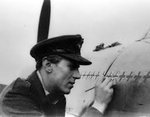Readie
Chief Master Sergeant
Douglas Bader
1910-1982
Bader had 20 victories, four shared, six probables, one shared probable and 11 damaged. These numbers alone may not stand up to some of the others on this list but what makes his tally truly remarkable is that he achieved all of this despite having no legs (having lost them in a 1931 plane crash). Having enjoyed plenty of combat success in the early stages of the war, in 1941 his luck deserted him, when he was downed and captured by the Germans. He was held in such high regard though, that his captors, including the great German Ace Adolf Galland, arranged for a new prosthetic leg to be delivered from Britain, while he was incarcerated.
Another candidate.
Cheers
John
1910-1982
Bader had 20 victories, four shared, six probables, one shared probable and 11 damaged. These numbers alone may not stand up to some of the others on this list but what makes his tally truly remarkable is that he achieved all of this despite having no legs (having lost them in a 1931 plane crash). Having enjoyed plenty of combat success in the early stages of the war, in 1941 his luck deserted him, when he was downed and captured by the Germans. He was held in such high regard though, that his captors, including the great German Ace Adolf Galland, arranged for a new prosthetic leg to be delivered from Britain, while he was incarcerated.
Another candidate.
Cheers
John

